Xeriscaping mistakes can sabotage your efforts to create a beautiful and sustainable landscape. While the concept of xeriscaping, or water-wise gardening, seems straightforward, many common errors can lead to plant failure, increased water usage, and aesthetic issues. From selecting the wrong plants to neglecting proper soil preparation, these mistakes can undermine the very principles of xeriscaping.
This guide explores the most frequent pitfalls encountered during xeriscape design and implementation, offering insights and solutions to help you avoid these common errors. By understanding the principles of xeriscaping and the potential pitfalls, you can create a thriving, water-efficient landscape that will flourish for years to come.
Understanding Xeriscaping Principles
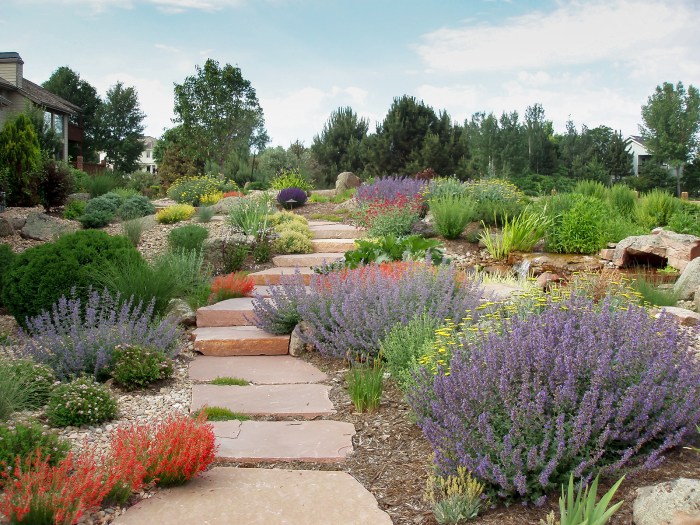
Xeriscaping, derived from the Greek word “xeros” meaning dry, is a landscaping approach that emphasizes water conservation and uses drought-tolerant plants. This method is becoming increasingly popular as water resources become more scarce and climate change leads to prolonged dry periods.
Xeriscaping goes beyond simply saving water; it offers numerous benefits, making it a sustainable and practical landscaping choice.
Benefits of Xeriscaping
Xeriscaping offers a range of benefits beyond water conservation, including:
- Reduced Maintenance: Xeriscaping requires less frequent watering, weeding, and mowing, leading to a significant reduction in maintenance time and effort.
- Environmental Benefits: By reducing water consumption, xeriscaping minimizes the strain on water resources and promotes a more sustainable environment. It also contributes to reducing runoff and erosion, protecting local ecosystems.
- Cost Savings: Lower water bills and reduced maintenance costs contribute to significant financial savings over time.
- Increased Biodiversity: Xeriscaping can attract a variety of pollinators and beneficial insects, promoting biodiversity in your landscape.
Drought-Tolerant Plant Species
Xeriscaping utilizes plants that are naturally adapted to dry conditions, requiring minimal irrigation. Here are some common examples of drought-tolerant plants:
- Succulents: These plants, such as cacti, agave, and sedums, store water in their leaves, stems, or roots, allowing them to thrive in arid environments.
- Grasses: Many grasses, including buffalo grass, blue grama, and switchgrass, are drought-tolerant and require minimal watering.
- Shrubs: Desert willow, yucca, and Russian sage are examples of drought-tolerant shrubs that can add texture and color to your landscape.
- Trees: Some trees, such as palo verde, mesquite, and desert ironwood, are adapted to dry conditions and can provide shade and visual interest.
Common Xeriscaping Mistakes
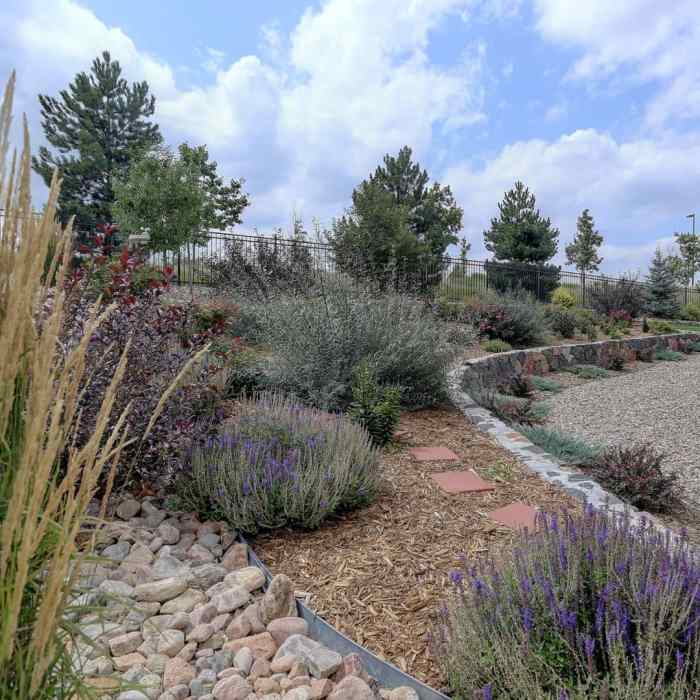
Xeriscaping, while an effective water-saving strategy, can sometimes lead to unintended consequences if not implemented correctly. Common mistakes during xeriscape design and implementation can result in plant failure, increased water usage, and aesthetic issues. Understanding these mistakes and how to avoid them is crucial for achieving a successful and sustainable xeriscape.
Plant Selection
Choosing the wrong plants is a common xeriscaping mistake. Xeriscaping isn’t about planting only cacti and succulents; it’s about selecting plants adapted to your specific climate and soil conditions.
- Selecting plants that are not drought-tolerant:Choosing plants that require more water than your climate provides can lead to plant stress, disease, and ultimately, failure. This can also increase water usage, negating the benefits of xeriscaping.
- Ignoring microclimates:Different areas within your landscape might have varying sun exposure, wind patterns, and soil conditions. Ignoring these microclimates and planting the same species everywhere can lead to plant failure in certain areas.
- Overlooking plant spacing:Planting too densely can create competition for water and nutrients, leading to stunted growth and plant failure. Proper spacing allows plants to thrive and reduces the need for excessive watering.
Irrigation
Proper irrigation is essential for xeriscaping success. Overwatering or under-watering can lead to plant stress and disease.
- Using the wrong irrigation system:Drip irrigation is generally preferred for xeriscaping because it delivers water directly to the plant roots, reducing evaporation and runoff. However, using a sprinkler system designed for lawns can lead to overwatering and wasted water.
- Improperly setting the timer:Setting the timer too long or too often can lead to overwatering, which can suffocate roots and make plants susceptible to disease.
- Not considering soil type:Different soil types retain water differently. Clay soils hold water longer than sandy soils. It’s important to adjust your irrigation schedule based on your soil type.
Soil Preparation
Soil preparation is crucial for xeriscaping. Poorly prepared soil can lead to poor drainage, nutrient deficiencies, and plant stress.
Xeriscaping, a water-wise landscaping technique, can sometimes lead to unintended consequences. One such issue is the creation of overly dry conditions, which can be detrimental to certain plants. Similar to the challenges faced with root rot in orchids and treatment , where excess moisture is the culprit, xeriscaping can also lead to root damage if not properly implemented.
By understanding the needs of the plants in your landscape, you can avoid these pitfalls and create a thriving, water-efficient garden.
- Ignoring soil amendments:Xeriscaping often involves improving soil structure and water retention. Adding organic matter like compost can improve drainage, aeration, and water retention, enhancing plant health.
- Not addressing soil compaction:Compacted soil restricts root growth and water infiltration. Proper soil preparation involves loosening compacted soil to improve drainage and allow roots to spread.
- Failing to test soil pH:Soil pH affects nutrient availability. Testing your soil pH and adjusting it to the ideal range for your plants is essential for optimal growth and water efficiency.
Maintenance
Proper maintenance is key to a successful xeriscape.
- Neglecting mulching:Mulch helps retain moisture, suppress weeds, and regulate soil temperature.
- Over-pruning:Pruning can be beneficial for shaping plants and removing dead or diseased branches. However, over-pruning can stress plants and make them more vulnerable to disease.
- Not removing weeds:Weeds compete with your xeriscape plants for water and nutrients. Regularly removing weeds is crucial for the health and success of your xeriscape.
Plant Selection Errors

Choosing the wrong plants is a common mistake in xeriscaping, as it can lead to a landscape that is not only unattractive but also unsustainable. The success of xeriscaping relies on selecting plants that are truly drought-tolerant and well-suited to the specific climate and growing conditions.
Considering Climate and Growing Conditions
When selecting plants for xeriscaping, it is crucial to consider the specific climate and growing conditions of your region. This includes factors such as:
- Sunlight Exposure:Plants have different sunlight requirements. Choosing plants that thrive in the amount of sunlight your landscape receives is essential for their survival and growth.
- Soil Type:Different plants have different soil preferences. Some plants prefer sandy soils, while others thrive in clay soils. Selecting plants that are compatible with the soil type in your landscape will ensure their health and longevity.
- Plant Maturity:It’s essential to consider the mature size of the plants you choose. Some plants may start small but can grow significantly larger over time, potentially crowding other plants or structures in your landscape.
Examples of Misleading Plant Choices
Many plants are often mistakenly chosen for xeriscaping due to their attractive appearance, but they lack true drought tolerance. Some common examples include:
- Turfgrass:While some varieties of turfgrass are marketed as drought-tolerant, they generally require more water than native grasses and other xeriscape-friendly plants.
- Certain Ornamental Grasses:Some ornamental grasses, while attractive, require significant water to thrive, especially in hotter climates. It is essential to choose grasses specifically labeled as drought-tolerant for your region.
- Non-Native Trees:Many non-native trees, particularly those from humid climates, struggle to survive in arid environments. Selecting native trees adapted to drought conditions is crucial for long-term success.
Irrigation Mismanagement
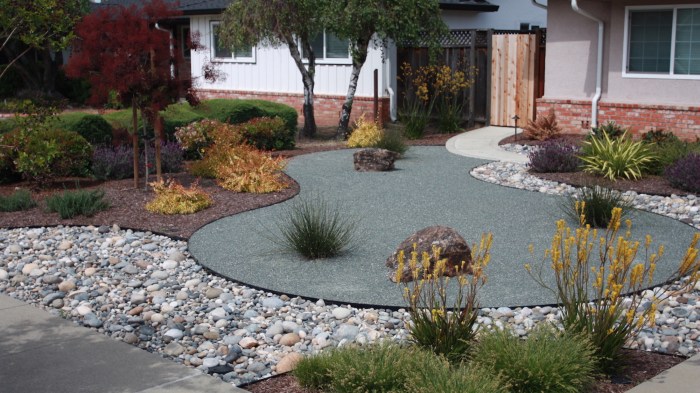
Xeriscaping, a water-wise landscaping approach, emphasizes efficient water usage. However, even in xeriscaping, irrigation mismanagement can undo the benefits of drought-tolerant plants and lead to wasted water, plant stress, and even landscape damage. Common mistakes include overwatering, improper watering schedules, and inefficient watering methods.
Importance of Water-Efficient Irrigation Systems and Techniques
Water-efficient irrigation systems and techniques are crucial for xeriscaping success. They ensure that water is delivered precisely where it is needed, minimizing waste and maximizing plant health. By optimizing irrigation, you can conserve water, reduce maintenance costs, and promote a thriving xeriscape landscape.
Different Irrigation Methods
Various irrigation methods are available, each with its own pros and cons, making some more suitable for specific xeriscape designs than others. Here’s a table comparing different methods:
| Irrigation Method | Pros | Cons | Suitability for Xeriscape Designs |
|---|---|---|---|
| Drip Irrigation | Precise water delivery, minimizes runoff, efficient water use, ideal for individual plants, suitable for various plant types. | Higher initial installation cost, potential clogging issues, requires maintenance. | Suitable for most xeriscape designs, especially for smaller plants and areas with limited space. |
| Soaker Hoses | Simple and affordable, efficient water delivery, suitable for larger areas and rows of plants. | Less precise water distribution than drip irrigation, potential for waterlogging if not used correctly. | Suitable for larger xeriscape areas with uniform plant spacing. |
| Sprinkler Systems | Wide coverage, suitable for large lawns and areas with high water demand, can be automated. | Water loss through evaporation, potential for overwatering, less efficient water use compared to other methods. | Less suitable for xeriscaping, except for limited use in specific areas requiring occasional watering. |
| Hand Watering | Precise water application, ideal for container plants and small areas, minimizes water waste. | Labor-intensive, time-consuming, not practical for large areas. | Suitable for small xeriscape areas, container plants, and supplemental watering for established plants. |
Soil Preparation Oversights
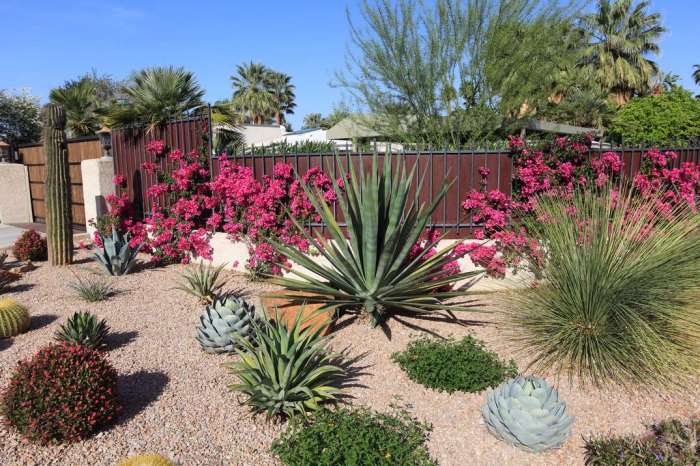
Proper soil preparation is a critical component of successful xeriscaping. Neglecting this crucial step can lead to a cascade of problems, ultimately hindering the long-term health and resilience of your drought-tolerant landscape.
While xeriscaping can be beneficial for water conservation, it’s important to avoid common mistakes. One of these is neglecting the soil’s nutrient content, which can lead to issues like tomato seedlings turning yellow due to nutrient deficiencies. Xeriscaping doesn’t mean neglecting the soil altogether; it simply requires strategic planting and water management to thrive in arid environments.
Soil Structure and Water Retention
Soil structure plays a pivotal role in water retention. Well-structured soil, with a balanced ratio of sand, silt, and clay, allows water to infiltrate readily while also providing adequate drainage. Conversely, compacted or poorly structured soil can impede water penetration, leading to water runoff and insufficient moisture for plant roots.
This can result in stressed plants, susceptible to disease and pests, ultimately jeopardizing the entire xeriscaping endeavor.
Preparing Soil for Xeriscaping
- Assess Existing Soil Conditions:Begin by evaluating the existing soil. Determine its texture (sandy, loamy, or clay), drainage characteristics, and overall health. This initial assessment will guide subsequent soil amendments and preparation techniques.
- Remove Existing Vegetation:Clear the planting area of existing vegetation, including weeds and unwanted plants. This ensures a clean slate for optimal soil preparation and plant establishment.
- Amend the Soil:Incorporate organic amendments such as compost, aged manure, or shredded bark into the soil. These amendments improve soil structure, aeration, and water retention. The ideal ratio of organic matter to soil will depend on the existing soil conditions and plant requirements.
- Till or Dig the Soil:Till or dig the soil to a depth of at least 12 inches, incorporating the amendments thoroughly. This process improves soil aeration and allows roots to penetrate deeply, accessing essential nutrients and moisture.
- Create Raised Beds:Consider creating raised beds for certain xeriscape plants, especially those that prefer well-drained conditions. Raised beds elevate the planting area, promoting better drainage and reducing the risk of waterlogging.
- Apply Mulch:Once the plants are established, apply a layer of organic mulch, such as wood chips or shredded bark, around the base of the plants. Mulch helps retain soil moisture, suppress weeds, and regulate soil temperature.
Lack of Mulching
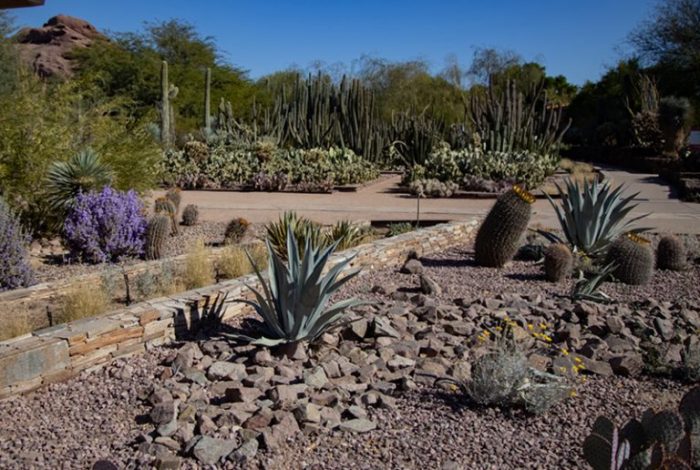
Mulching is an essential practice in xeriscaping, offering numerous benefits that contribute to the success of a water-wise landscape. By applying a layer of mulch around plants, you create a protective barrier that helps retain moisture, suppress weeds, and regulate soil temperature.
Types of Mulch Suitable for Xeriscaping
Mulch plays a vital role in maintaining a healthy xeriscape. Different types of mulch offer varying advantages, making it crucial to select the appropriate option for your specific needs. Here’s a table comparing popular mulch types and their suitability for different xeriscape scenarios:
| Mulch Type | Advantages | Suitable for |
|---|---|---|
| Bark Mulch | Naturally decomposes, providing nutrients to the soil. Available in various sizes and colors. | Trees, shrubs, and larger plants. |
| Wood Chips | Economical and readily available. Provides good weed suppression. | Trees, shrubs, and flower beds. |
| Straw | Lightweight and easy to apply. Helps retain moisture and suppress weeds. | Vegetable gardens and around young plants. |
| Gravel | Durable and low-maintenance. Reflects heat, keeping soil cooler. | Rock gardens, paths, and around succulents. |
| Pea Gravel | Decorative and provides excellent drainage. | Paths, walkways, and around drought-tolerant plants. |
| Rubber Mulch | Long-lasting and requires minimal maintenance. Available in various colors. | Playgrounds, around water features, and areas with high foot traffic. |
Ignoring Maintenance
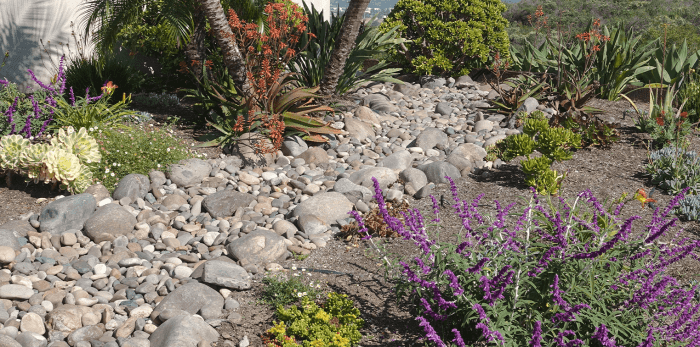
Xeriscaping, while designed for low water usage, isn’t a “set it and forget it” approach. Just like any garden, it requires regular maintenance to thrive and remain attractive. Neglecting maintenance can lead to a decline in the xeriscape’s health, aesthetics, and effectiveness.
Essential Maintenance Tasks, Xeriscaping mistakes
Several essential tasks contribute to the long-term success of a xeriscape. These include:
- Pruning:Regular pruning encourages healthy growth and prevents overcrowding, which can hinder air circulation and sunlight penetration. It also helps maintain the desired shape and size of plants, ensuring a visually appealing landscape.
- Weeding:Weeds compete with xeriscape plants for water and nutrients, potentially hindering their growth and health. Regular weeding ensures the xeriscape plants have the resources they need to flourish.
- Pest Control:While xeriscaping often utilizes drought-tolerant and pest-resistant plants, occasional pest infestations can occur. Regular monitoring and prompt action, such as using organic pest control methods, can prevent widespread damage and maintain the xeriscape’s health.
Seasonal Maintenance Schedule
A structured maintenance schedule helps ensure all essential tasks are addressed at the appropriate times, maximizing the xeriscape’s health and beauty. Here’s a suggested schedule:
- Spring:
- Prune overgrown or dead branches to encourage new growth.
- Apply a layer of mulch to retain moisture and suppress weeds.
- Inspect for and address any pest problems.
- Summer:
- Monitor water needs and adjust irrigation as necessary.
- Continue weeding and pruning as needed.
- Inspect for and address any pest problems.
- Fall:
- Prune back dead or diseased branches.
- Add a fresh layer of mulch to protect plants during winter.
- Prepare for winter by ensuring irrigation systems are winterized (if applicable).
- Winter:
- Inspect for and address any winter damage.
- Remove any fallen leaves or debris to prevent disease and pest problems.
- Monitor for any signs of pest or disease activity.
End of Discussion
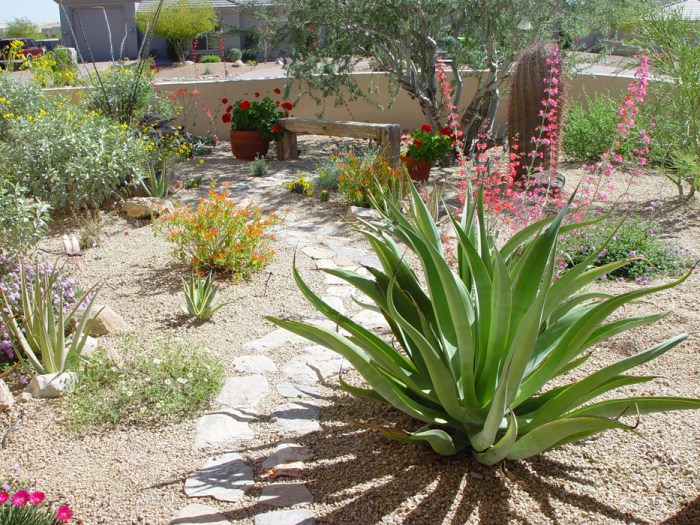
Xeriscaping, when executed correctly, can be a rewarding and sustainable approach to landscaping. By understanding and avoiding common mistakes, you can create a water-wise landscape that not only conserves precious resources but also enhances the beauty and functionality of your outdoor space.
Remember, xeriscaping is a journey, and by learning from others’ experiences and applying the principles of water conservation, you can create a landscape that thrives for years to come.